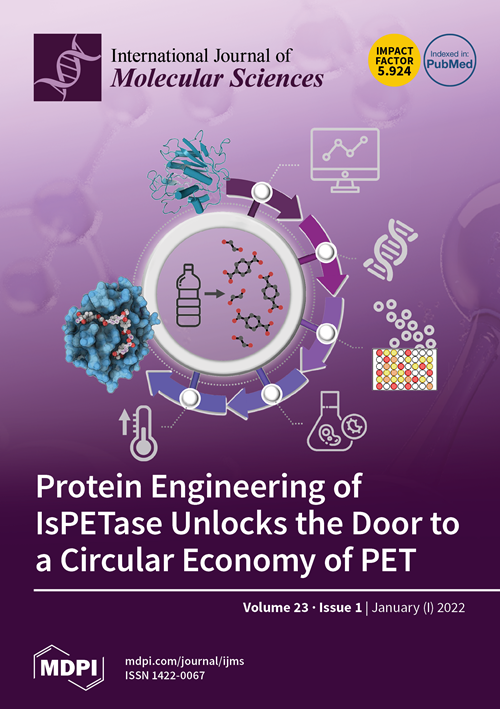胶质瘤中光动力疗法抗药性和光敏剂给药改进的分子决定因素
IF 4.9
2区 生物学
Q1 BIOCHEMISTRY & MOLECULAR BIOLOGY
引用次数: 0
摘要
胶质瘤占所有原发性脑和中枢神经系统(CNS)肿瘤的 24%。这些肿瘤的细胞来源、遗传特征和形态多种多样,但总体而言,它们是预后最差的癌症之一。人们一直在努力探索一种新的有效治疗胶质瘤的方法。光动力疗法(PDT)可能是其中之一。它包括局部或全身应用一种光敏化合物--光敏剂(PS),这种化合物会在受影响的组织中积聚。光敏剂分子吸收适当波长的光,启动活化过程,形成活性氧并选择性地破坏不适当的细胞。有关在胶质瘤治疗中有效使用光导疗法的研究已经在进行中,并取得了令人鼓舞的成果。在我们的工作中,我们详细了解了光动力疗法后胶质瘤的分子变化。我们描述了一些可能导致胶质瘤细胞对光动力疗法产生抗药性的分子,如三磷酸腺苷(ATP)结合盒外排转运体 G2、谷胱甘肽、铁螯合酶、血红素加氧酶和缺氧诱导因子 1。我们发现了可用于改善光敏剂向胶质瘤细胞输送的分子靶点,如上皮生长因子受体、神经蛋白-1、低密度脂蛋白受体和神经肽 Y 受体。我们注意到,光动力疗法会增加一些降低治疗效果的分子的表达,如血管内皮生长因子(VEGF)、谷氨酸和一氧化氮。然而,科学文献中缺乏有关光紫外疗法对上述许多分子影响的明确数据,而且现有的报告往往相互矛盾。在我们的工作中,我们强调了这方面知识的不足,并指出了进一步研究的方向,这些研究可能会提高光动力疗法治疗胶质瘤的疗效。本文章由计算机程序翻译,如有差异,请以英文原文为准。
Molecular Determinants for Photodynamic Therapy Resistance and Improved Photosensitizer Delivery in Glioma
Gliomas account for 24% of all the primary brain and Central Nervous System (CNS) tumors. These tumors are diverse in cellular origin, genetic profile, and morphology but collectively have one of the most dismal prognoses of all cancers. Work is constantly underway to discover a new effective form of glioma therapy. Photodynamic therapy (PDT) may be one of them. It involves the local or systemic application of a photosensitive compound—a photosensitizer (PS)—which accumulates in the affected tissues. Photosensitizer molecules absorb light of the appropriate wavelength, initiating the activation processes leading to the formation of reactive oxygen species and the selective destruction of inappropriate cells. Research focusing on the effective use of PDT in glioma therapy is already underway with promising results. In our work, we provide detailed insights into the molecular changes in glioma after photodynamic therapy. We describe a number of molecules that may contribute to the resistance of glioma cells to PDT, such as the adenosine triphosphate (ATP)-binding cassette efflux transporter G2, glutathione, ferrochelatase, heme oxygenase, and hypoxia-inducible factor 1. We identify molecular targets that can be used to improve the photosensitizer delivery to glioma cells, such as the epithelial growth factor receptor, neuropilin-1, low-density lipoprotein receptor, and neuropeptide Y receptors. We note that PDT can increase the expression of some molecules that reduce the effectiveness of therapy, such as Vascular endothelial growth factor (VEGF), glutamate, and nitric oxide. However, the scientific literature lacks clear data on the effects of PDT on many of the molecules described, and the available reports are often contradictory. In our work, we highlight the gaps in this knowledge and point to directions for further research that may enhance the efficacy of PDT in the treatment of glioma.
求助全文
通过发布文献求助,成功后即可免费获取论文全文。
去求助
来源期刊

International Journal of Molecular Sciences
Chemistry-Organic Chemistry
CiteScore
8.10
自引率
10.70%
发文量
13472
审稿时长
17.49 days
期刊介绍:
The International Journal of Molecular Sciences (ISSN 1422-0067) provides an advanced forum for chemistry, molecular physics (chemical physics and physical chemistry) and molecular biology. It publishes research articles, reviews, communications and short notes. Our aim is to encourage scientists to publish their theoretical and experimental results in as much detail as possible. Therefore, there is no restriction on the length of the papers or the number of electronics supplementary files. For articles with computational results, the full experimental details must be provided so that the results can be reproduced. Electronic files regarding the full details of the calculation and experimental procedure, if unable to be published in a normal way, can be deposited as supplementary material (including animated pictures, videos, interactive Excel sheets, software executables and others).
 求助内容:
求助内容: 应助结果提醒方式:
应助结果提醒方式:


